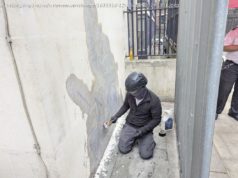The company that designed the bridge that fell onto Southwest Eighth Street built spans all over the country and earned considerable acclaim. Some are considered gems.
The founder of the FIGG Bridge Group engineering firm was so widely admired that the nation’s oldest civil engineering association named a scholarship after him.
FIGG is a bit of a rarity among engineering firms: It designs only bridges — spans over briny bays, over green mountain hollers, over congested urban roadways and over the Colorado River en route to Utah’s red rock marvels.
The company, based in Tallahassee, designed a bridge that spans Tampa Bay, the iconic Sunshine Skyway, which replaced an earlier structure that had been the subject of one of the most stunning, and tragic, collapses in U. S. history. It designed the Seven Mile Bridge in the Florida Keys. It developed the Linn Cove Viaduct — the final piece of the breathtaking Blue Ridge Parkway in North Carolina — which was designated a National Civil Engineering Landmark.
NASA chose FIGG to repair bridges at both the Kennedy Space Center and Cape Canaveral Air Force Station, and the firm replaced the Interstate 35 bridge in Minneapolis that toppled to the ground in 2007 — a $233.8 million project that includes 10 lanes of traffic. On a less grand scale, FIGG designed the pedestrian bridge over Tallahassee’s Cascades Park, which turned a gas plant pollution debacle into an urban gem.
After a 175-foot stretch of the FIU University/City Prosperity Project bridge collapsed Thursday — taking at least six lives below it — FIGG, which designed the bridge, issued a statement through a publicist: “This pedestrian bridge collapse is truly tragic. The focus right now is on the first responders’ recovery operations. Multiple agencies have already begun an extensive review to determine what caused the collapse, and we will work closely with all appropriate authorities in this effort.”
The statement referred to the collapse as “an unprecedented event” — twice. An earlier statement Thursday said: “In our 40-year history, nothing like this has ever happened before.”
But the mishap was not an entirely isolated event.
In 2012, a 90-ton piece of concrete plunged to the ground when a portion of the Jordan Bridge, then under construction, collapsed near Norfolk, Virginia. It was about 4 p.m. on June 21,2012, when a portion of the bridge measuring 52 feet long and 10 feet wide toppled. The South Norfolk Jordan Bridge traverses the Southern Branch Elizabeth River, from the cities of Portsmouth to Chesapeake. FIGG was overseeing the project as South Norfolk Jordan Bridge, LLC.
The Virginian-Pilot reported at the time that the builder did not get a manufacturer’s written consent before it modified a girder that ultimately failed, causing the span to crash. Litigation followed, and the Norfolk and Portsmouth Belt Line Railroad Company sued FIGG in 2013, alleging the collapsed bridge “completely blocked” the rail line’s tracks, and damaged its switch scanner, track bed and crossing.
The Belt Line’s service was interrupted for a little over a week, an April 2013 lawsuit said, which was about how long it took to explode the fallen bridge and remove it. The rail line alleged damages of more than a half-million; the suit was settled, and then dismissed.
The federal Occupational Safety and Health Administration, or OSHA, fined FIGG $28,000 for its role in the Virginia bridge collapse, which included eight separate citations, three of which were considered “serious,” records show. The Virginia Department of Labor also cited the firm for four violations.
FIGG — which has offices in Alabama, Texas, Colorado, Minnesota and Pennsylvania — was founded 40 years ago by Eugene Figg Jr., a Citadel graduate and structural engineer who is credited with helping to revolutionize bridge development through the use of segmental construction. Eugene Figg died in 2002, and his daughter, Linda Figg, is the firm’s president and CEO.
FIGG was embroiled in another legal dispute in the late 1990s and early 2000s after a separate construction company, Odebrecht-Metric, was accused of dumping tons of construction debris into Pensacola Bay.
The project — derisively called “Bo’s Bridge” after the powerful Panhandle lawmaker who bullied through its development — had been a magnet for controversy virtually from the moment former Florida House Speaker Bolley “Bo” Johnson proposed it. Critics charged, among other things, that the two-lane bridge connecting U. S. Route 98 with Interstate 10 and Route 90 near Milton would never collect enough tolls to retire the $95 million bond issue that paid for it.
And they were right: The project defaulted in 2002, and has been an albatross on the state ever since. The Legislature considered two proposals this session that would allow the state to take ownership of the bridge from the Santa Rosa Bay Bridge Authority — and either change toll rates or issue new bonds to pay back bondholders. Lawmakers eventually decided to do nothing, which could prompt bondholders to force them to increase tolls to try and make up the more than $135 million they are owed.
Critics also charged that the bridge construction would spawn an environmental mess — and they were right about that, too.
The project is formally called the Garcon Point Bridge. Odebrecht-Metric reportedly got a bonus for building the span ahead of schedule.
The accelerated pace of construction may have been aided by an unorthodox method of waste disposal. Between 1997 and 1999, Odebrecht dumped much of its construction debris — including concrete, concrete pilings, and steel reinforcement bars — directly into the open water, the U. S. Justice Department said.
“The company’s permit allowed it to dump non-hazardous construction debris several miles off the coast in the Gulf of Mexico, where it could have been properly used as reef material,” prosecutors said at the time. Instead, “investigative dives and sonar have revealed that, as a result of the criminal activity, at least 3.75 acres of construction debris had been left under the bridge span on the bottom of the East Bay and the Pensacola Bay.”
The company and three of its supervisors pleaded guilty to environmental crimes, and Odebrecht agreed to pay a total of $4 million in fines and restitution.
FIGG was not prosecuted. But the company was supposed to be inspecting and overseeing Odebrecht’s work, and faced withering accusations that it looked the other way while Odebrecht workers despoiled the bay — allegations FIGG vehemently denied.
“If a contractor is going to make an illegal dumping, they are not going to do it in front of an inspector,” Linda Figg told what is now called the Tampa Bay Times in 2001.
Start
United States
USA — Art Acclaimed designer of FIU bridge says collapse ‘unprecedented.’ But is it?






